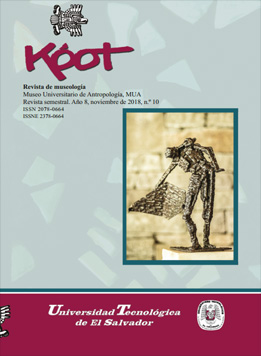Ethnography of the municipality of Santa María Ostuma; land of pineapple, legends and traditions
Published 2019 - 01 -31
Keywords
- Cultural heritage,
- Anthropology,
- Ethnography,
- Culture,
- Cultural identity
Copyright (c) 2019 Kóot

This work is licensed under a Creative Commons Attribution-NonCommercial-ShareAlike 4.0 International License.
How to Cite
Abstract
The students and the faculty of the school of Anthropology at UTEC conducted an ethnographic work on the municipality of Santa María Ostuma in 2017 which results have been presented in an article. The study included an approach based on sociocultural anthropology, providing the dimension of the socio-historical and cultural-organizational expressions of this municipality, based on the production and commercialization of their emblematic product: the pineapple. Different local dynamics are explained within this study, such as the economic entrepreneurship of the people and the tangible and intangible patrimonial construct around this fruit, which can be seen in the beliefs, artistic production, legends and the spiritual-religious traditions. An example of these are the palancas logs with hanging pineapples, coconuts, oranges, moonshine and animals that are carried during the procession, the pineapple fairs and the mayordomía select group of people in charge of the festivities to the patron saint Virgin of Candelaria, among others. The study applied an ethnographic-qualitative method thus interviews and focal groups were used; data was analyzed with Nvivo. A drone also videotaped the emblematic places of the municipality. Among the results it can be mentioned that the pineapple is viewed as the most relevant product of the area, being in first place the azucarón (extra sweet) or India (creole) varieties. The pineapple is seen as the traditional fruit that they call “the heritage of Ostuma” hence conferring onto it a sense of belonging for the inhabitants of the municipality.
Keywords: Cultural heritage; Anthropology; Ethnography; Culture; Cultural identity.
DOI: http://doi.org/10.5377/koot.v0i10.6703
URI: http://hdl.handle.net/11298/789
